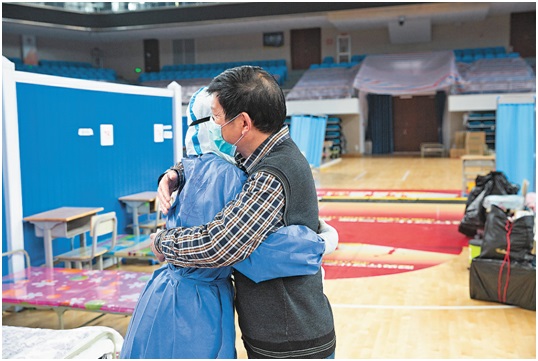By People’s Daily
All 16 Fangcang makeshift hospitals in Wuhan, the epicenter of the coronavirus outbreak in central China’s Hubei Province, were closed Tuesday after the final batch of 49 patients walked out of the Wuchang temporary hospital.
The Fangcang hospitals, a pioneering practice in the history of medical rescue, played a major role in the battle against the novel coronavirus epidemic, earned valuable experiences for dealing with major public health emergencies, and showcased Chinese wisdom.
The closure was celebrated by all medical workers from 14 provinces treating patients there, who embraced the moment of excitement with the first laughter they made in 35 days of operation.
“The reception of the first batch of patients still lingers on my mind,” said Hu Xing, a nurse from east China’s Jiangxi province, who worked in the Fangcang hospital in Wuchang district. The hospital, starting to admit patients on Feb. 5, was the first Fangcang facility opened in the city.
The 800-bed hospital received more than 300 patients in 24 hours upon opening, which kept Hu and other medics working all night long. “It was the first time for me to serve so many confirmed coronavirus patients. The work was intense and I was a little bit nervous,” Hu recalled.
When patients first arrived at the hospitals, they might find it hard to adapt to the new environment. “We regarded the patients as our family, and offered psychological counseling to them,” said Li Xiaofang, Hu’s colleague. “Gradually, we became friends and some cured patients even volunteered to lend a hand,” she added.
A man surnamed Song was one that offered help. He was found helping medical workers make their beds hours before the closure. “I’d like to help them because what they did was extremely tiring,” he said.
To show their gratitude, patients wrote their best wishes on the protective suit of Tai Shi, a medic with the Second Xiangya Hospital of Central South University from central China’s Hunan province. “A little patient told me that he wants to be a doctor like us when he grows up,” Tai said.
A cured patient surnamed Zhang, in his fifties, was still playing Go game with a nurse before he left the hospital. “He lost the other day, so he wants to defeat me before he goes,” said the nurse, and Zhang cracked up.
By March 10, the Wuchang Fangcang hospital has admitted 1,124 patients, and cured and discharged 833. A total of 869 medical staff from 9 provinces nationwide joined together in this hospital, turning from peers into “comrades in arms” in this battle against the epidemic.
“I want to thank the comrades in arms who came from around the country to help us,” said Ma Yonggang, executive vice-president of the Wuchang Fangcang hospital and the medical team leader of the People’s Hospital of Wuhan University, as he bowed to the medical workers.
“We may not able to recognize each other when we take off the masks, but we will always be a family as a member of this hospital,” said Huang Liming, vice president of the Second Affiliated Hospital of Guizhou University of Traditional Chinese Medicine, and head of the treatment team of the 5th batch of medical team to assist Hubei from southwest China’s Guizhou province.
The closure of the Fangcang hospitals in Wuhan marks an important phased achievement of the fight against the novel coronavirus pneumonia.
The hospitals, used to receive patients with mild symptoms, were converted from Wuhan International Conference and Exhibition Center, Wuchang Hongshan Stadium, and other urban facilities since Feb. 3, and supported by over 8,000 medical workers from 94 medical teams across the country.
In more than 30 days since the first cabin hospital was commissioned, the 16 cabin hospitals in Wuhan cured over 12,000 patients with mild symptoms, or a quarter of the total infected in the city.
A cured coronavirus patient hugs a medic who has taken care of him during his treatment in the Wuchang Fangcang hospital, before the hospital closes, March 10, 2020. Photo by Zhang Wujun, People’s Daily












Leave a Comment